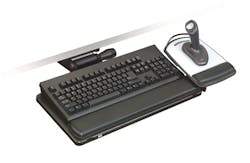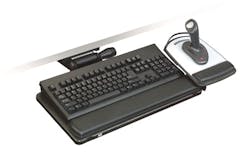Adjustable Shared Workstations: Savings on the Move
Many businesses have started using shared workspaces to maximize the use of their buildings' floor space. It can be cost prohibitive to provide dedicated office space for someone who generally telecommutes or spends most of his or her time as a visitor at a client's site. As a result, many businesses are "hoteling" (providing unassigned workstations for users to "check in" and use for the amount of time needed, and they can then "check out" when they're done). How common is this practice? Framingham, MA-based PeopleCube says that, "As of 2007, 73 percent of Fortune 500 companies offer ‘hot desking' or unassigned workstations."
While many companies strive for financial gains from shared office workspaces, it's vital to keep in mind the effects on individual productivity - in other words, don't throw the baby out with the bathwater. Ergonomics research over the past 20 years has consistently shown that workstations adjusted to fit the user can result in up to an 18-percent productivity increase. With several people of varying sizes using the same chair, monitor, and keyboard, shared workstations require adjustable furniture and equipment so that individual users can effortlessly customize the workstation.
What are the critical adjustment features for a shared workspace? The most basic requirements include a good, adjustable chair and adjustable mounting solutions for displays and input devices. There is generally a 9- to 10-inch difference in eye height between a tall man and a small woman; a shared workstation should be able to accommodate that difference.
The monitor should be placed so that the viewing distance between the screen and the user's eyes is at least 20 inches. The top of the screen should be no higher than the user's eyes, and the center of the screen should be about 15- to 30-degrees (about one-quarter to one-half the viewing distance) below the user's horizontal eye level.
Input devices (keyboards and pointing devices) should be placed at about the same height as the user's elbows. Interestingly, there is less difference in the range of elbow heights than in eye heights between a tall man and a small woman; consequently, it's a good idea to be able to adjust monitor height independently of the height of the input device support.
The chair at a shared workstation needs to adjust in height so that the user can sit with his or her feet firmly supported, either on a footrest or on the floor. A good backrest with lumbar support, along with clearance between the front of the seat and the back of the user's knees, are also critical components. Most office chairs are specifiable in varying seat sizes and back heights, so make sure you pick a model that can accommodate the range of body types using the workstation.
Shared workspaces offer attractive benefits and advantages with regard to minimizing real estate costs. At the same time, shared workstations need to adjust to fit each individual user to achieve those space-related cost savings without adverse effects on user comfort and productivity.
Tom Albin, a certified professional ergonomist and licensed professional engineer, is a consultant for St. Paul, MN-based 3M Workspace Solutions.

